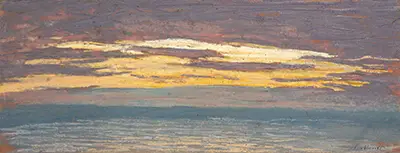In the lower right is the artist’s signature. Monet uses different shades of colour to illustrate the dying light at sunset. Critics and supporters believed Monet did his drawings and paintings spontaneously, but in reality he planned his work, which at times involved pastel and sketch versions of his paintings.
Under the tutelage of Charles Gleyre, Monet refined his craft and learned to use new brush strokes and colour techniques to show different lighting effects.
Unlike paint, pastels can be used immediately and no mixing or drying time is needed. This gave Monet the freedom to work quickly and to experiment with colours and textures than was possible with other mediums.
In View of the Sea at Sunset we can see how pastel colours are used to light and dark scenes with dramatic effect. The dying lighting depicts the final moments of sunlight perfectly. Shades of grey and yellow combine to create an almost gloomy mood.
When the conservative Salon de Paris rejected their pleas for change, Monet and other Impressionists were forced to break away and to organise their own exhibitions. The first Impressionist exhibition took place from April 15 to May 15, 1874 and included artists Claude Monet, Camille Pissarro and Edgar Degas.
Monet exhibited three oil paintings, four watercolours and six pastels. Claude Monet is one of the world's most renowned painters, but he was relatively unknown as a pastel artist. He often gave his pastel works to his patrons, clients, and friends as gifts, downplaying their importance in his works, believing they would diminish his status as an innovative artist.
Famous names from the Italian Renaissance helped to lay the ground work for all the impressionists that followed several centuries later. Highlights from that extensive era include Michelangelo's Creation of Adam, Da Vinci's Mona Lisa and Raphael's School of Athens.
Monet portrayed himself in public as an artist who painted freely from nature. Unlike Morisot and other artists, he rarely used pastels to outline his paintings. Pastels are versatile and available usually in four types: hard, soft, pencil, and oil. The drawings appear smudged and dreamy, diffuse even.
His pictures images look like frescoes and have a feel of immediacy. Colour variation is used to create form, tone, shape and lighting. By the time he reached his later years, pastels were a regular feature of his art. His work Sailboats behind the Needle at Etretat, dated to 1885, contrasted with his oil canvas of a similar theme, is dark and edgy.
Other pastel drawings by Monet include Le Plateau de Caux, Charing Cross Bridge (1901), and Waterloo Bridge (1901). Pastel works dated between 1878 and 1885 were produced during a period of turbulence in his life, his wife had died in 1879, at the age of 32, and his financial situation was precarious. Paintings from the same period were on relatively tranquil, hinting at none of difficulties he faced. Edgar Degar, Camille Pissarro and Pierre-Auguste Renoir (see Dance at Le Moulin de la Galette) were among the notable artists of the era who used pastels to great effect.
Although Monet said he believed pastels could diminish his status as a revolutionary artist, he drew almost 108 works on paper, mostly of smaller size than his large oil paintings. The View of the Sea at Sunset is small, at 15.3 cm x 40 cm, yet evokes emotion and motion. The pastel is currently housed in the Museum of Fine Arts in Boston and was bequeathed by William P. Blake, in 1922, in memory of his sister Anne Dehon Blake.


